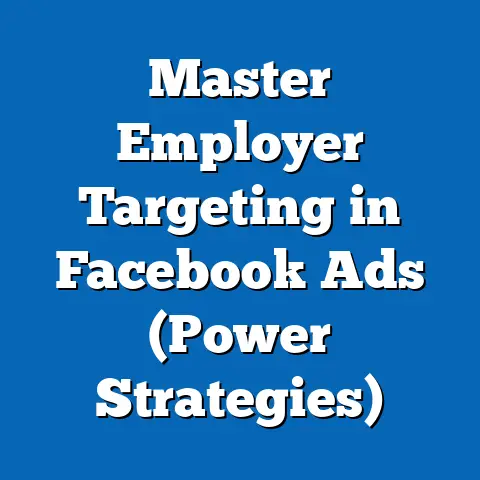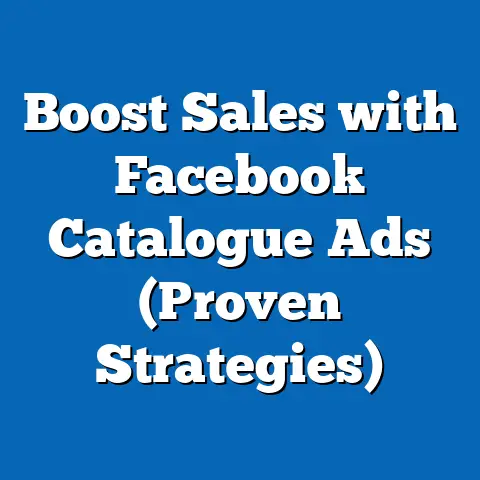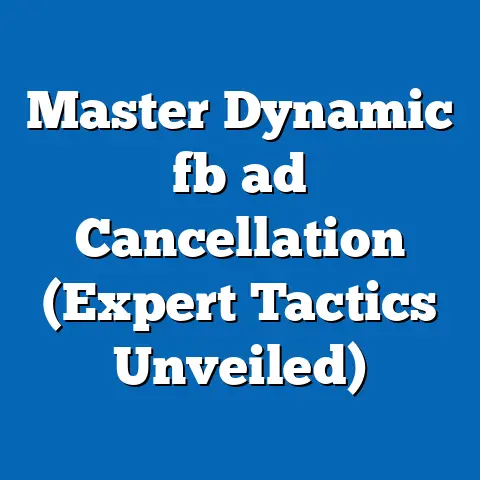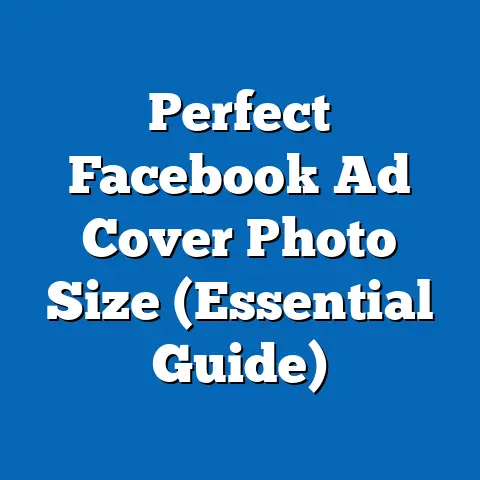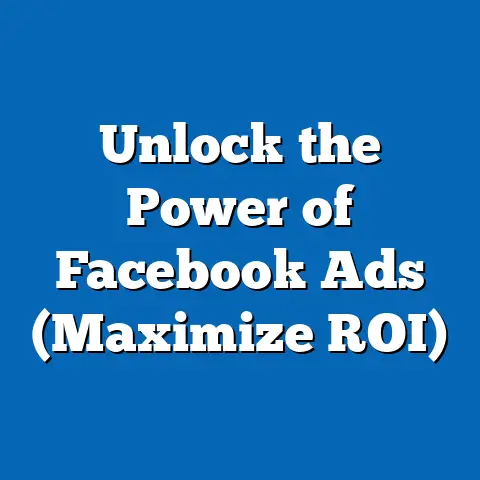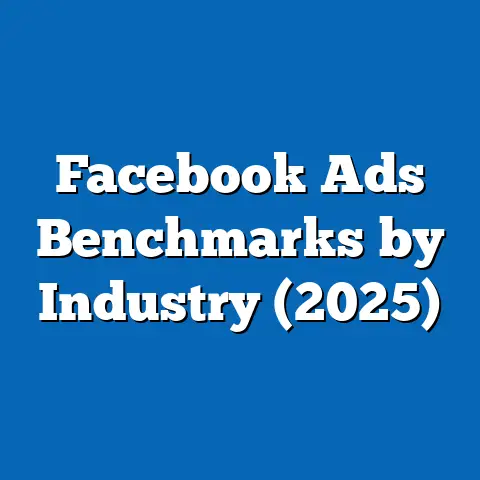Revitalize Facebook Ads: Boost Engagement (Pro Strategies)
Have you ever felt like your Facebook ads are just… invisible? I know the feeling. I’ve been there, staring at disappointing engagement numbers, wondering where all the potential customers are hiding. The truth is, in today’s crowded digital landscape, simply throwing up a generic ad isn’t going to cut it. I’ve seen countless businesses, big and small, fall into the trap of relying on cookie-cutter templates, only to watch their budgets evaporate with little to show for it.
I remember working with a local bakery who was convinced that a simple picture of their best-selling cake, paired with a standard “Order Now!” button, would be enough to drive sales. They were disheartened when their campaign yielded minimal results. The problem? Their ad looked just like everyone else’s! It lacked personality, a compelling story, and any real connection with their target audience.
The consequences of this mistake are real. Low engagement rates translate to fewer clicks, fewer website visits, and ultimately, fewer conversions. You’re not just wasting money; you’re missing out on opportunities to connect with potential customers and build brand loyalty. Industry data consistently shows that ads with higher engagement have significantly better ROI. Without a strong engagement strategy, your ads are essentially shouting into the void.
That’s why I’m writing this guide. It’s time to ditch the generic and embrace a new approach to Facebook advertising. It’s time to revitalize your ads and unlock their true potential. We’re going to dive deep into proven strategies that will transform your ad performance, boost engagement, and drive real results. By understanding your audience, utilizing advanced targeting techniques, and embracing creativity, you can turn your Facebook ads into powerful tools for growth. I’ve personally seen these strategies work wonders for my clients, and I’m excited to share them with you. Let’s get started!
Key Takeaway: Generic ads are a recipe for disaster. Revitalizing your Facebook ads requires a strategic approach focused on audience understanding, compelling content, and advanced targeting.
1. Understanding Your Audience
Before you even think about crafting an ad, you need to understand who you’re talking to. I’ve learned over the years that successful Facebook advertising isn’t about broadcasting your message to everyone; it’s about connecting with the right people.
1.1 Importance of Audience Research
Think of it this way: Would you try to sell snow to Eskimos? Probably not. The same logic applies to your Facebook ads. You need to know your target market inside and out. What are their interests? What are their pain points? What motivates them?
Audience research helps you answer these questions. It allows you to identify the specific demographics, interests, and behaviors of your ideal customers. This information is crucial for crafting ads that resonate with them and drive engagement.
I’ve seen firsthand how audience research can completely transform a campaign. Once, I worked with a fitness studio that was struggling to attract new members. They were running generic ads targeting “people interested in fitness.” After conducting thorough audience research, we discovered that their ideal customer was a busy mom in her late 30s, interested in quick and effective workouts that fit into her hectic schedule. By tailoring their ads to this specific audience, they saw a significant increase in sign-ups and engagement.
There are several tools and methods you can use for audience analysis:
- Facebook Audience Insights: This free tool provides valuable data about your target audience, including their demographics, interests, page likes, and location. I highly recommend starting here. It’s a goldmine of information.
- Facebook Analytics: Track user behavior on your website and within your Facebook page. This will help you understand how people are interacting with your brand and what content resonates with them.
- Surveys: Conduct surveys to gather direct feedback from your target audience. Ask them about their needs, preferences, and challenges.
- Customer Interviews: Talk to your existing customers to learn more about their motivations and experiences.
- Competitor Analysis: Analyze your competitors’ target audience to identify potential opportunities and gaps in the market.
Key Takeaway: Audience research is the foundation of successful Facebook advertising. Use available tools and methods to gain a deep understanding of your target market.
1.2 Creating Audience Personas
Once you’ve gathered enough data, it’s time to create audience personas. An audience persona is a fictional representation of your ideal customer. It’s a detailed profile that includes their demographics, interests, motivations, pain points, and goals.
Creating audience personas helps you humanize your target market and develop a deeper understanding of their needs and desires. This, in turn, allows you to craft ads that speak directly to them and resonate on a personal level.
I’ve found that giving my personas names and even finding stock photos that resemble them helps me connect with them on a more personal level. It makes them feel more real and helps me keep them in mind when I’m crafting ad copy or choosing visuals.
Here are a few examples of effective audience personas:
- “Sarah, the Busy Mom”: Sarah is a 35-year-old working mom with two young children. She’s always on the go and struggles to find time for herself. She’s interested in quick and effective workouts, healthy recipes, and time-saving tips.
- “Mark, the Tech Enthusiast”: Mark is a 28-year-old software engineer who’s passionate about technology and gadgets. He’s always looking for the latest innovations and loves to share his knowledge with others.
- “Emily, the Fashion Blogger”: Emily is a 24-year-old fashion blogger who loves to experiment with different styles and trends. She’s always on the lookout for new brands and products to feature on her blog.
When creating your own audience personas, be as specific as possible. The more detailed your personas are, the better you’ll be able to craft ads that resonate with them.
Key Takeaway: Audience personas are fictional representations of your ideal customers. They help you humanize your target market and craft ads that resonate on a personal level.
1.3 Segmenting Audiences for Precision Targeting
Segmentation is the process of dividing your target audience into smaller, more homogeneous groups based on specific characteristics. This allows you to create more personalized ads that are tailored to the needs and interests of each segment.
I’ve seen businesses achieve incredible results by segmenting their audiences. For example, an e-commerce store selling clothing could segment their audience by gender, age, location, and interests. They could then create separate ad campaigns for each segment, featuring products that are relevant to their specific demographics.
Here are a few strategies for creating segmented campaigns:
- Demographics: Segment your audience by age, gender, location, education, and income.
- Interests: Segment your audience by their interests, hobbies, and passions.
- Behaviors: Segment your audience by their online behavior, such as website visits, purchases, and engagement with your content.
- Custom Audiences: Create custom audiences based on your existing customer data, such as email lists and website visitors.
- Lookalike Audiences: Create lookalike audiences based on your existing customer data. This allows you to target new customers who are similar to your best customers.
Segmenting your audiences allows you to create more relevant and engaging ads, which leads to higher click-through rates, lower costs, and ultimately, better results.
Key Takeaway: Segmentation allows you to create more personalized ads that are tailored to the needs and interests of specific groups within your target audience.
2. Crafting Compelling Ad Content
Now that you understand your audience, it’s time to create ad content that grabs their attention and compels them to take action. In the world of Facebook advertising, content is king. You can have the best targeting in the world, but if your ad is boring or irrelevant, it’s not going to work.
2.1 The Power of Storytelling in Ads
People are naturally drawn to stories. Stories evoke emotions, create connections, and make your brand more relatable. By incorporating storytelling into your ads, you can capture your audience’s attention and leave a lasting impression.
I’ve seen firsthand how storytelling can transform an ad campaign. I worked with a non-profit organization that was struggling to raise funds for their programs. They were running generic ads asking for donations. After incorporating storytelling into their ads, they saw a significant increase in donations. They shared stories of the people they were helping, highlighting the impact their work was having on the community.
Here are a few examples of successful ads that utilized storytelling effectively:
- Dove’s “Real Beauty” campaign: This campaign challenged traditional beauty standards and celebrated the beauty of real women. It resonated with millions of people and generated a huge amount of positive buzz.
- Airbnb’s “Belong Anywhere” campaign: This campaign showcased the unique experiences people could have by staying in Airbnb homes around the world. It tapped into the desire for adventure and connection.
- Always’ “Like a Girl” campaign: This campaign challenged gender stereotypes and encouraged girls to embrace their strength and confidence. It sparked a global conversation and inspired millions of people.
When crafting your own story, think about the emotions you want to evoke. Do you want to make people laugh? Do you want to inspire them? Do you want to make them feel nostalgic? Choose a story that is relevant to your brand and your target audience.
Key Takeaway: Storytelling is a powerful tool for capturing your audience’s attention and creating an emotional connection with your brand.
2.2 Visuals and Design Principles
In the fast-paced world of social media, visuals are essential for grabbing attention. People are scrolling through their feeds at lightning speed, and you have just a few seconds to make an impression. That’s why it’s crucial to use high-quality visuals that are eye-catching, relevant, and engaging.
I’ve learned that even the most compelling copy can fall flat if it’s paired with a poorly designed visual. I worked with a client who had a fantastic product, but their ads were consistently underperforming. The problem? Their visuals were amateurish and didn’t accurately represent their brand. After investing in professional photography and graphic design, their ad performance skyrocketed.
Here are a few tips for choosing visuals and applying design principles to your Facebook ads:
- Use high-quality images and videos: Avoid blurry or pixelated images. Invest in professional photography or video production if necessary.
- Choose visuals that are relevant to your brand and your target audience: Use images and videos that reflect your brand’s personality and appeal to your target audience’s interests.
- Use color psychology to evoke specific emotions: Different colors evoke different emotions. Use color strategically to create the desired effect.
- Use typography to create a visual hierarchy: Use different font sizes and styles to guide the viewer’s eye and highlight important information.
- Keep your design clean and simple: Avoid cluttering your ad with too many elements. Less is often more.
- Use a strong call to action: Make it clear what you want people to do after seeing your ad.
Key Takeaway: High-quality visuals are essential for grabbing attention and making a strong impression. Pay attention to design principles to create ads that are visually appealing and effective.
2.3 Writing Engaging Copy
Your ad copy is just as important as your visuals. It’s your opportunity to tell your story, highlight your value proposition, and persuade people to take action. Writing engaging ad copy requires a combination of creativity, empathy, and strategic thinking.
I’ve found that the best ad copy is clear, concise, and compelling. It speaks directly to the needs and desires of the target audience and offers a solution to their problems.
Here are a few techniques for writing persuasive ad copy:
- Start with a strong headline: Your headline is the first thing people will see, so make it count. Use a headline that is attention-grabbing, relevant, and intriguing.
- Highlight your value proposition: What makes your product or service unique? What benefits do you offer? Clearly communicate your value proposition in your ad copy.
- Use emotional language: Connect with your audience on an emotional level by using language that evokes specific feelings.
- Use social proof: Show that other people have had positive experiences with your product or service. Include testimonials, reviews, and ratings in your ad copy.
- Use a strong call to action: Tell people exactly what you want them to do. Use a clear and concise call to action, such as “Shop Now,” “Learn More,” or “Sign Up Today.”
- Keep it short and sweet: People have short attention spans, so get to the point quickly. Use concise language and avoid unnecessary jargon.
Here are a few examples of strong headlines, calls-to-action, and value propositions that have led to increased engagement:
- Headline: “Tired of feeling tired? Discover the energy-boosting secret that’s changing lives.”
- Call to Action: “Claim Your Free Trial Today!”
- Value Proposition: “Our organic skincare products are made with natural ingredients that nourish and protect your skin, leaving you feeling radiant and confident.”
Key Takeaway: Persuasive ad copy is clear, concise, and compelling. It speaks directly to the needs and desires of the target audience and offers a solution to their problems.
3. Utilizing Advanced Targeting Techniques
While compelling content is crucial, it’s wasted if it’s not reaching the right audience. That’s where advanced targeting techniques come into play. Facebook offers a powerful suite of targeting options that allow you to reach specific demographics, interests, and behaviors.
3.1 Custom Audiences and Lookalike Audiences
Custom Audiences allow you to target people who have already interacted with your business, either online or offline. This includes people who have visited your website, purchased your products, signed up for your email list, or engaged with your Facebook page.
I’ve seen businesses achieve incredible results by using Custom Audiences to retarget website visitors who abandoned their shopping carts. By showing these visitors ads featuring the products they left behind, they were able to recover a significant amount of lost sales.
You can create Custom Audiences from various sources, including:
- Customer Lists: Upload your customer email list to target your existing customers on Facebook.
- Website Traffic: Install the Facebook Pixel on your website to track website visitors and create audiences based on their behavior.
- App Activity: Target people who have used your mobile app.
- Offline Activity: Target people who have interacted with your business offline, such as through in-store purchases.
Lookalike Audiences allow you to expand your reach to new customers who are similar to your existing customers. Facebook analyzes your Custom Audiences and identifies the common characteristics of those people. It then finds other people on Facebook who share those same characteristics.
Lookalike Audiences are a powerful tool for finding new customers who are likely to be interested in your products or services. I’ve found that they often outperform traditional targeting methods.
Key Takeaway: Custom Audiences and Lookalike Audiences are powerful tools for targeting people who are already familiar with your brand or who are likely to be interested in your products or services.
3.2 Engagement Retargeting Strategies
Engagement retargeting is the process of targeting users who have engaged with your previous ads or content. This includes people who have liked your page, commented on your posts, watched your videos, or clicked on your ads.
These users have already shown an interest in your brand, making them more likely to convert into customers. Engagement retargeting is a highly effective way to nurture leads and drive sales.
I’ve seen businesses achieve significant results by retargeting users who watched a certain percentage of their video ads. By showing these users a follow-up ad with a special offer, they were able to convert a significant number of them into customers.
Here are a few examples of engagement retargeting strategies:
- Retarget users who liked your page: Show them ads featuring your latest products or services.
- Retarget users who commented on your posts: Engage with them directly and offer them a special discount.
- Retarget users who watched your videos: Show them a follow-up ad with a call to action.
- Retarget users who clicked on your ads: Show them ads featuring the products or services they clicked on.
Key Takeaway: Engagement retargeting is a highly effective way to nurture leads and drive sales by targeting users who have already shown an interest in your brand.
3.3 Geo-Targeting and Timing Strategies
Geo-targeting allows you to target people based on their location. This can be as broad as targeting an entire country or as specific as targeting a single neighborhood.
Geo-targeting is particularly useful for businesses that have a local presence, such as restaurants, retail stores, and service providers. I’ve helped countless local businesses use geo-targeting to reach potential customers in their area.
Timing strategies involve scheduling your ads to run at specific times of day or days of the week. This allows you to reach your target audience when they are most likely to be online and engaged.
I’ve found that the best times to run ads vary depending on the industry and the target audience. For example, a restaurant might find that the best times to run ads are during lunch and dinner hours, while a clothing store might find that the best times to run ads are on weekends.
You can use Facebook’s ad scheduling feature to schedule your ads to run at specific times. You can also use Facebook Analytics to track your ad performance at different times of day and days of the week.
Key Takeaway: Geo-targeting and timing strategies allow you to reach your target audience at the right place and at the right time, maximizing your ad effectiveness.
4. Leveraging Facebook Ad Formats and Features
Facebook offers a variety of ad formats and features that can help you engage your audience and achieve your marketing goals. It’s important to experiment with different formats and features to find what works best for your brand.
4.1 Exploring Different Ad Formats
Here are a few of the most popular Facebook ad formats:
- Image Ads: Simple and effective, image ads feature a single image and a short description. They are ideal for showcasing your products or services in a visually appealing way.
- Video Ads: Video ads are highly engaging and can be used to tell your brand story, demonstrate your products, or share customer testimonials.
- Carousel Ads: Carousel ads allow you to showcase multiple images or videos in a single ad unit. They are ideal for highlighting different features of your products or services.
- Collection Ads: Collection ads are designed for e-commerce businesses. They feature a catalog of products that users can browse directly from the ad.
- Instant Experience Ads: Instant Experience ads are full-screen, mobile-optimized ads that load instantly. They are ideal for creating immersive brand experiences.
Each ad format has its own unique benefits. I’ve found that video ads tend to have the highest engagement rates, but image ads are often more cost-effective. Carousel ads are great for showcasing multiple products, while collection ads are ideal for e-commerce businesses.
It’s important to test different ad formats to see what works best for your brand and your target audience.
Key Takeaway: Facebook offers a variety of ad formats, each with its own unique benefits. Experiment with different formats to find what works best for your brand and your target audience.
4.2 Utilizing Facebook Stories and Reels
Facebook Stories and Reels are short-form video formats that are incredibly popular with younger audiences. They are a great way to connect with your audience in a fun and engaging way.
I’ve seen businesses achieve significant results by incorporating Stories and Reels into their ad strategies. They are a great way to showcase your brand’s personality, share behind-the-scenes content, and promote your products or services.
Here are a few tips for creating engaging Stories and Reels:
- Keep it short and sweet: Stories and Reels are designed to be consumed quickly, so keep your content concise and to the point.
- Use eye-catching visuals: Use high-quality images and videos that are visually appealing and attention-grabbing.
- Add music and sound effects: Music and sound effects can help to enhance the emotional impact of your content.
- Use interactive elements: Add polls, quizzes, and questions to encourage engagement.
- Showcase your brand’s personality: Let your brand’s personality shine through in your Stories and Reels.
Key Takeaway: Facebook Stories and Reels are powerful tools for connecting with younger audiences and showcasing your brand’s personality.
4.3 Integrating Facebook Shops and Product Tags
Facebook Shops allows businesses to create a storefront directly on Facebook. This allows customers to browse your products, make purchases, and track their orders without ever leaving the Facebook app.
Product tags allow you to tag your products in your Facebook posts and ads. When users click on a product tag, they are taken directly to the product page on your website or in your Facebook Shop.
I’ve seen businesses significantly increase their sales by integrating Facebook Shops and product tags into their ad strategies. They are a great way to drive traffic to your website and make it easier for customers to purchase your products.
Here are a few success stories of brands that have effectively integrated shopping features within their ads:
- Sephora: Sephora uses Facebook Shops and product tags to showcase their latest beauty products and make it easy for customers to purchase them directly from their ads.
- Nike: Nike uses Facebook Shops and product tags to promote their latest athletic gear and drive traffic to their website.
- H&M: H&M uses Facebook Shops and product tags to showcase their latest fashion trends and make it easy for customers to purchase them directly from their ads.
Key Takeaway: Integrating Facebook Shops and product tags into your ad strategies can significantly increase your sales and make it easier for customers to purchase your products.
5. Analyzing and Optimizing Ad Performance
Running Facebook ads is not a “set it and forget it” kind of thing. You need to constantly analyze your ad performance and make adjustments to optimize your results.
5.1 Key Metrics to Track for Engagement
Here are a few of the key metrics you should be tracking to gauge the success of your Facebook ads:
- Click-Through Rate (CTR): The percentage of people who see your ad and click on it. A high CTR indicates that your ad is relevant and engaging.
- Engagement Rate: The percentage of people who interact with your ad, such as liking, commenting, or sharing it. A high engagement rate indicates that your ad is resonating with your audience.
- Conversion Rate: The percentage of people who take the desired action after clicking on your ad, such as making a purchase or signing up for your email list. A high conversion rate indicates that your ad is effective at driving results.
- Cost Per Click (CPC): The amount you pay each time someone clicks on your ad. A low CPC indicates that your ad is efficient at driving traffic.
- Cost Per Acquisition (CPA): The amount you pay each time someone takes the desired action after clicking on your ad. A low CPA indicates that your ad is effective at driving results at a reasonable cost.
I’ve learned that it’s important to track these metrics over time to identify trends and patterns. This will help you understand what’s working and what’s not, and make informed decisions about how to optimize your ad performance.
Key Takeaway: Tracking key metrics is essential for understanding the performance of your Facebook ads and making informed decisions about how to optimize your results.
5.2 A/B Testing for Continuous Improvement
A/B testing, also known as split testing, is the process of comparing two versions of your ad to see which one performs better. This allows you to test different elements of your ads, such as visuals, copy, and targeting, to identify what resonates best with your audience.
I’ve seen businesses achieve significant results by A/B testing their Facebook ads. It’s a simple but powerful way to improve your ad performance and maximize your ROI.
Here’s a framework for conducting A/B tests:
- Identify the element you want to test: Do you want to test different visuals? Different headlines? Different calls to action?
- Create two versions of your ad: Change only the element you are testing. Keep everything else the same.
- Run your ads: Run both versions of your ad simultaneously for a set period of time.
- Analyze the results: Track the performance of each version of your ad and identify which one performed better.
- Implement the winning version: Implement the winning version of your ad and continue to test other elements.
Key Takeaway: A/B testing is a simple but powerful way to improve your Facebook ad performance by testing different elements of your ads and identifying what resonates best with your audience.
5.3 Iterating Based on Data Insights
The data you collect from your Facebook ads provides valuable insights into your audience’s behavior and preferences. By analyzing this data, you can identify what’s working and what’s not, and make informed decisions about how to refine your ad strategies.
I’ve seen businesses successfully pivot their ad strategies based on performance metrics. For example, if you notice that your ads are performing well with one demographic but not with another, you can adjust your targeting to focus on the demographic that is responding best.
Here are a few examples of how you can use data insights to refine your ad strategies:
- Identify your best-performing visuals: Use the data to identify the visuals that are generating the most clicks and engagement. Use these visuals in future ads.
- Identify your best-performing copy: Use the data to identify the copy that is generating the most clicks and conversions. Use this copy in future ads.
- Identify your best-performing targeting: Use the data to identify the targeting options that are generating the most clicks and conversions. Focus your targeting on these options.
- Identify your best-performing ad formats: Use the data to identify the ad formats that are generating the most clicks and conversions. Focus your efforts on these formats.
Key Takeaway: Data insights are essential for refining your Facebook ad strategies and maximizing your ROI.
Conclusion
Revitalizing your Facebook ads is not a one-time task; it’s an ongoing process of learning, testing, and optimizing. By understanding your audience, crafting compelling content, utilizing advanced targeting techniques, leveraging Facebook’s ad formats and features, and constantly analyzing and optimizing your ad performance, you can unlock the true potential of your Facebook ads and drive real results for your business.
I know it can seem overwhelming, but I encourage you to take action today. Reassess your current Facebook ads and implement the pro strategies outlined in this article. Start by conducting thorough audience research, creating detailed audience personas, and crafting compelling ad copy that speaks directly to their needs and desires. Then, experiment with different ad formats and features, and track your results carefully.
Remember, the key to success on Facebook is to be creative, data-driven, and audience-centric. Don’t be afraid to try new things, and don’t give up if you don’t see results immediately. With consistent effort and a strategic approach, you can transform your Facebook ads into powerful tools for growth.
Now go out there and revitalize your Facebook ads! Your audience is waiting.

